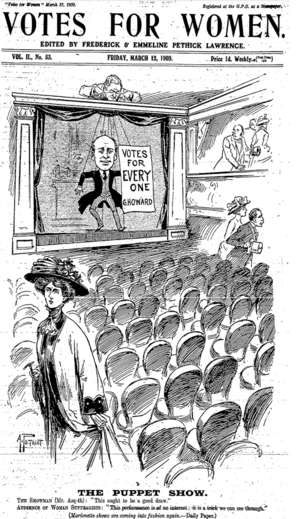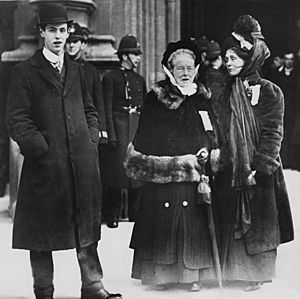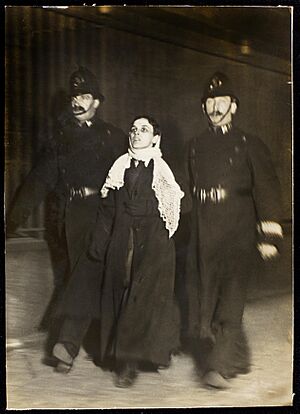Black Friday (1910) facts for kids
Black Friday was a big protest in London on November 18, 1910. About 300 women marched to the Houses of Parliament. They were fighting for women's right to vote. The day got its name because of the rough treatment the protesters received from the police and men watching.
In January 1910, the Prime Minister, H. H. Asquith, promised a new law called the Conciliation Bill. This bill would have given some women the right to vote. When he won the election, a group of politicians from different parties worked on this bill. It would have allowed about a million women to vote. Women's rights groups supported it. Even though politicians voted for the bill twice, Asquith would not give it more time in Parliament.
On November 18, 1910, Asquith called for another election. He said Parliament would close soon. The Women's Social and Political Union (WSPU) felt tricked. They organized a protest march to Parliament from Caxton Hall. Around 300 women protesters were met by police and crowds of men. The women were attacked for about six hours. Police arrested 4 men and 115 women. But the next day, all charges were dropped. A committee was upset by what happened. They interviewed 135 protesters, and most of them described being treated badly. Calls for a public investigation were turned down by Winston Churchill, who was in charge of police at the time.
Some people believed the violence might have caused the deaths of two women who protested. After this day, the WSPU changed how they protested. Many members did not want to risk such violence again. They went back to actions like throwing stones or breaking windows, which allowed them to escape more easily. The police also changed their methods for future protests.
Contents
Why They Protested
The Women's Social and Political Union
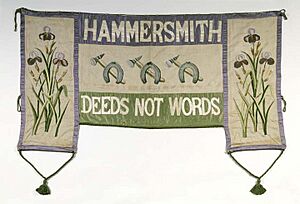
The Women's Social and Political Union (WSPU) was started in 1903 by Emmeline Pankhurst. Around 1905, after a try to get women the vote failed, the WSPU started using more direct and strong actions. A historian named Caroline Morrell said that from 1905, the WSPU's plan was clear: use strong tactics, go to prison to gain attention, and get more members and money.
From 1906, WSPU members were called suffragettes. This was to show they were different from the suffragists of the National Union of Women's Suffrage Societies. Suffragists used peaceful, legal ways to campaign for the vote. From 1907, WSPU protests faced more police violence. Sylvia Pankhurst, Emmeline's daughter, described a protest in February 1907:
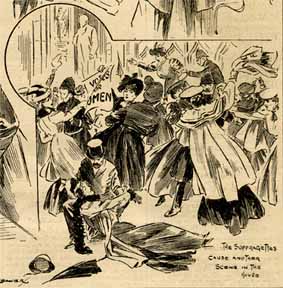
Police guarded Parliament to stop the women. Police officers were told to push them away, making few arrests. Mounted police scattered the marchers. Foot police grabbed them and pushed them along, hitting them in the back. Those who hid in doorways were pulled out and thrown in front of horses. Then police grabbed them and hit them again. As night came, the violence grew. In the end, 54 women and 2 men were arrested.
After a protest in June 1908, Sylvia Pankhurst said the police and rough crowds treated the women very badly. In June 1909, a group tried to meet with Prime Minister Asquith. Three thousand police officers stopped the women from entering Parliament. They arrested 108 women and 14 men. After this police violence, the WSPU started breaking windows instead of trying to rush into Parliament. Sylvia Pankhurst wrote that if they had to go to prison to get the vote, it should be for breaking government windows, not women's bodies.
In October 1909, ten protesters were sent to the hospital after another attempt to enter Parliament. The suffragettes did not complain about the police violence. Constance Lytton wrote that they were told to hide their injuries. It was not their plan to get the police into trouble. The level of strong actions by suffragettes grew in 1909. Bricks were thrown at windows of Liberal Party meetings. Asquith was attacked after church. Roof tiles were thrown at police during another political event. Public opinion turned against these tactics. The government used this change in public feeling to bring in tougher rules. In October 1909, Herbert Gladstone, the person in charge of police, ordered that all prisoners on hunger strike should be fed by force.
The Political Situation
The Liberal government elected in 1905 made many changes. They passed laws to help with poverty, unemployment, and pensions. But the Conservative Party-led House of Lords often stopped these laws. In 1909, David Lloyd George introduced the "People's Budget." This budget aimed to share wealth more fairly. The House of Commons passed it, but the Lords rejected it. So, on December 3, 1909, Asquith called a new election for the next year. He wanted public support for his laws. During the election campaign, Asquith, who was against women voting, said he would introduce a Conciliation Bill if he won. Women's rights campaigners did not believe this promise.
The January 1910 election resulted in a hung parliament. This means no single party won enough seats to have a clear majority. The Liberals won the most seats, but only two more than the Conservatives. Asquith stayed in power with the help of the Irish Parliamentary Party.
On January 31, 1910, Emmeline Pankhurst announced that the WSPU would stop all strong actions. They would focus only on legal activities. For six months, the women's rights movement worked hard. They organized marches and meetings. Local councils passed resolutions supporting the bill. When the new Parliament met, a committee of politicians from different parties was formed. They were led by Lord Lytton. They suggested a law that would give voting rights to women who owned homes or businesses. This would add about a million women to the list of voters. The WSPU thought the bill was too limited, but they accepted it as an important first step.
The Conciliation Bill was introduced in Parliament on June 14, 1910. The question of women's voting rights caused disagreements within the government. Asquith said he would let the bill be discussed a second time, but no more time would be given to it. This meant it would fail. Nearly 200 politicians asked Asquith for more time to discuss the law, but he said no. The bill passed its second vote on July 11 and 12. But then Parliament stopped meeting until November. The WSPU decided to wait. If no more time was given to the bill, Christabel Pankhurst would lead a group to Parliament. They would demand the bill become law and refuse to leave. On November 12, a politician named Sir Edward Grey announced there would be no more time for the bill that year. The WSPU announced they would protest strongly at Parliament on November 18.
The Day of the Protest: November 18
On November 18, 1910, Asquith called for a new election. He said Parliament would close on November 28. All remaining time would be for government business. He did not mention the Conciliation Bill. At noon that day, the WSPU held a meeting at Caxton Hall. The event was well-known, and newspapers were ready for the protest. From Caxton Hall, about 300 members marched to Parliament. They wanted to speak directly to Asquith. The group was led by Emmeline Pankhurst. Important women like Dr. Elizabeth Garrett Anderson and Princess Sophia Duleep Singh were in the first group. They arrived at Parliament at 1:20 PM. Asquith's assistant told them the Prime Minister would not see them. They were then taken back outside to watch the protest.
In the past, protests at Parliament were handled by local police who understood the suffragettes. Sylvia Pankhurst wrote that these police treated the women with respect. But on Black Friday, police from other areas, like Whitechapel and the East End, were brought in. These officers were not used to dealing with suffragettes. Historians say it is hard to know exactly what happened because different groups gave very different stories.

Groups of women trying to reach Parliament Square were met by crowds of men. These men pushed the women around. As the women passed the men, they met lines of police officers. Instead of arresting them, the police treated them roughly and insulted them. The protest lasted for six hours. Police hit women trying to enter Parliament. Then they threw them into the crowds of onlookers, where they were treated badly again. Many suffragettes thought some of the men in the crowd were police officers in plain clothes. Caxton Hall was used all day as a place to treat suffragettes who were hurt.
What Happened Next
On November 18, 4 men and 115 women were arrested. The next morning, when they went to court, the government said that Winston Churchill had decided not to continue with the cases. All charges were dropped. Some people believe Churchill dropped the charges so that no one would investigate the police actions. On November 22, Asquith said that if his party won the next election, there would be time for a Conciliation Bill. The WSPU was angry because this promise was for the next Parliament, not right away. About 200 suffragettes marched on Downing Street. There were more fights with police, and 159 women and 3 men were arrested. The next day, another march on Parliament led to 18 arrests. Many charges from November 22 and 23 were also dropped later.
How People Reacted
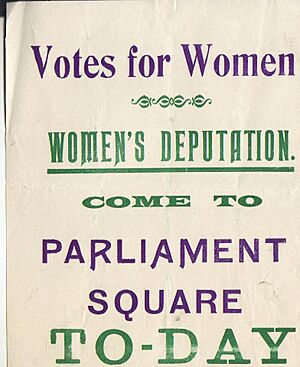
On November 19, 1910, newspapers reported on the events. Most newspapers did not mention police violence. They focused on how the suffragettes behaved. The front page of The Daily Mirror showed a large photo of a suffragette on the ground after being hit by a policeman. This was likely Ada Wright. The newspaper sent the photo to the police chief for comments. He first tried to say the woman had just collapsed from being tired. The photo was also in Votes for Women, The Manchester Guardian, and the Daily Express.
Newspapers often showed sympathy for the police. The Times reported that several police officers were hurt. The Daily Mirror wrote that the police were calm and avoided arrests. When Churchill decided not to charge the suffragettes, some newspapers criticized his choice.
On March 3, Georgiana Solomon, a suffragette at the protest, wrote to The Times. She said police had hurt her. She had been in bed and could not complain earlier. She had written to Churchill in December about what happened to her and what she saw. She got a reply but no further letter from the government. Her letter to Churchill was printed in the suffragette newspaper Votes for Women.
The WSPU leaders believed Churchill had told the police to handle the women roughly instead of arresting them quickly. Churchill denied this in Parliament. He was so angry he thought about suing Christabel Pankhurst and The Times for saying it. The November 25, 1910, Votes for Women newspaper said that police were told to be in uniform and in the crowd, and to throw women from one to another. Some historians disagree on whether Churchill gave such orders.
The Murray and Brailsford Report
When members of the committee heard the stories of the women's bad treatment, they asked for a public investigation. Churchill said no. A journalist named Henry Brailsford and a therapist named Jessie Murray collected 135 statements from protesters. Almost all of them described violence against the women.
On February 2, 1911, the report by Murray and Brailsford was given to the government. They formally asked for a public investigation. Churchill refused again. On March 1, he told Parliament that the report had many serious accusations against the police. He said these claims should have been made earlier. He also said his own checks found no truth in the statements that police were told to mistreat the women. He said police were told to act with control and moderation.
What Changed After Black Friday
The deaths of two suffragettes have been linked to the treatment they received on Black Friday. Mary Jane Clarke, Emmeline Pankhurst's younger sister, was at Black Friday and another protest on November 22. After a month in prison, she died on Christmas Day at age 48 from a brain bleed. Emmeline blamed her death on the bad treatment Mary received. However, the Murray and Brailsford report said they had no direct proof linking her death to the protests. The WSPU also said Henria Leech Williams died from bad treatment. Williams died of a heart attack on January 1, 1911. The report said there was proof she was treated very roughly and knew it affected her weak heart. Her brother later said she "knowingly and willingly shortened her days" helping women.
The events from November 18 to 25 affected WSPU members. Many no longer wanted to join protests. Marches to Parliament stopped. Stronger actions, like throwing stones and breaking windows, became more common. This allowed women to escape before police could arrest them. A historian named Elizabeth Crawford says Black Friday changed how the suffragettes and police interacted. After Black Friday, police tactics changed. In January 1911, a government official wrote to the police chief. He said it was best for police not to arrest too early or too late. This became the usual way police handled protests.
On November 17, 2010, a special event called "Remember the Suffragettes" was held to honor the women who took direct action.
See also
- Suffragette bombing and arson campaign


